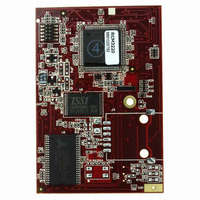20-101-0522 Rabbit Semiconductor, 20-101-0522 Datasheet - Page 17

20-101-0522
Manufacturer Part Number
20-101-0522
Description
MODULE RABBITCORE RCM3220
Manufacturer
Rabbit Semiconductor
Datasheet
1.20-101-0522.pdf
(96 pages)
Specifications of 20-101-0522
Module/board Type
MPU Core Module
Product
Microcontroller Modules
Core Processor
Rabbit 3000
Clock Speed
44.2 MHz
Interface Type
Ethernet, Serial
Flash
512 KB
Timers
10 x 8 bit, 1 x 10 bit
Operating Supply Voltage
3.15 V to 3.45 V
Board Size
69 mm x 47 mm x 22 mm
Core
RCM3220
Processor Series
RCM3200
For Use With/related Products
RCM3220
Lead Free Status / RoHS Status
Lead free / RoHS Compliant
Other names
316-1098
2.2.3 Programming Port
Serial Port A has special features that allow it to cold-boot the system after reset. Serial
Port A is also the port that is used for software development under Dynamic C.
The RCM3200 has a 10-pin program header labeled J3. The Rabbit 3000 startup-mode
pins (SMODE0, SMODE1) are presented to the programming port so that an externally
connected device can force the RCM3200 to start up in an external bootstrap mode. The
Rabbit 3000 Microprocessor User’s Manual provides more information related to the
bootstrap mode.
The programming port is used to start the RCM3200 in a mode where it will download a
program from the port and then execute the program. The programming port transmits
information to and from a PC while a program is being debugged in-circuit.
The RCM3200 can be reset from the programming port via the /RESET_IN line.
The Rabbit 3000 status pin is also presented to the programming port. The status pin is an
output that can be used to send a general digital signal.
The clock line for Serial Port A is presented to the programming port, which makes syn-
chronous serial communication possible.
Programming may also be initiated through the motherboard to which the RCM3200
series module is plugged in to since the Serial Port A (PC6 and PC7), SMODE0, SMODE1,
and /RESET_IN are available on headers J1 and J2 (see Table 1).
2.2.3.1 Alternate Uses of the Programming Port
The programming port may also be used as an application port with the
connector
DIAG
on the programming cable.
All three clocked Serial Port A signals are available as
• a synchronous serial port
• an asynchronous serial port, with the clock line usable as a general CMOS input
• two general CMOS inputs and one general CMOS output.
Two startup mode pins, SMODE0 and SMODE1, are available as general CMOS inputs
after they are read during the initial boot-up. The logic state of these two pins is very
important in determining the startup procedure after a reset.
/RES_IN is an external input used to reset the Rabbit 3000 microprocessor.
The status pin may also be used as a general CMOS output.
See Appendix E, “Programming Cable,” for more information.
User’s Manual
13

















